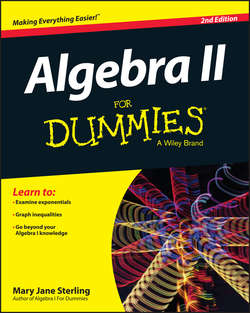Читать книгу Algebra II For Dummies - Sterling Mary Jane - Страница 7
На сайте Литреса книга снята с продажи.
Part I
Homing in on Basic Solutions
Chapter 1
Going Beyond Beginning Algebra
Zeroing in on the Multiplication Property of Zero
ОглавлениеYou may be thinking that multiplying by zero is no big deal. After all, zero times anything is zero, right? Yes, and that’s the big deal. You can use the multiplication property of zero when solving equations. If you can factor an equation – in other words, write it as the product of two or more multipliers – you can apply the multiplication property of zero to solve the equation. The multiplication property of zero states that
If the product of , at least one of the factors has to represent the number 0.
The only way the product of two or more values can be zero is for at least one of the values to actually be zero. If you multiply (16)(467)(11)(9)(0), the result is 0. It doesn’t really matter what the other numbers are – the zero always wins.
The reason this property is so useful when solving equations is that if you want to solve the equation x7 – 16x5 + 5x4 – 80x2 = 0, for instance, you need the numbers that replace the x’s to make the equation a true statement. This particular equation factors into x2(x3 + 5)(x – 4)(x + 4) = 0. The product of the four factors shown here is zero. The only way the product can be zero is if one or more of the factors is zero. For instance, if x = 4, the third factor is zero, and the whole product is zero. Also, if x is zero, the whole product is zero. (Head to Chapters 3 and 8 for more info on factoring and using the multiplication property of zero to solve equations.)
The birth of negative numbers
In the early days of algebra, negative numbers weren’t an accepted entity. Mathematicians had a hard time explaining exactly what the numbers illustrated; it was too tough to come up with concrete examples. One of the first mathematicians to accept negative numbers was Fibonacci, an Italian mathematician. When he was working on a financial problem, he saw that he needed what amounted to a negative number to finish the problem. He described it as a loss and proclaimed, “I have shown this to be insoluble unless it is conceded that the man had a debt.”
